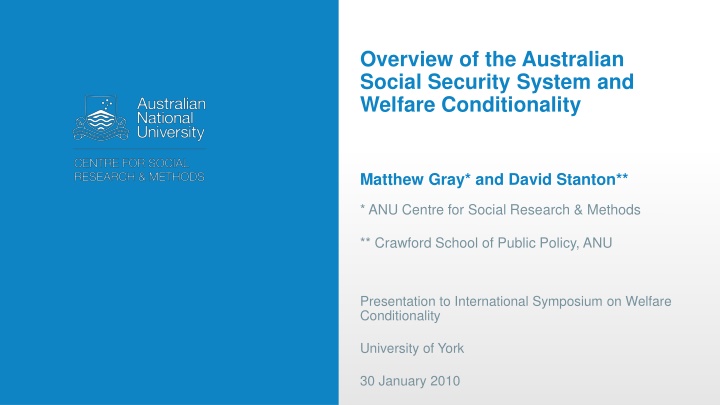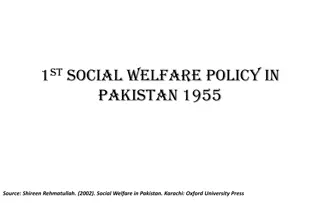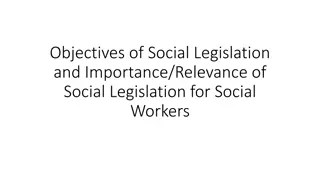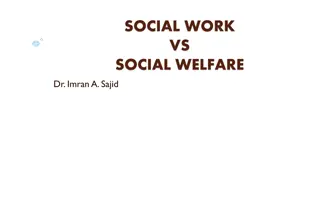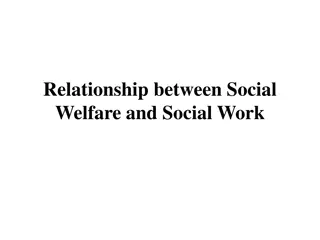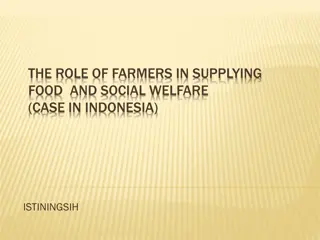Overview of Australian Social Security System and Welfare Conditionality
The Australian social security system provides flat-rate entitlements from general government revenue to ensure a minimum level of income support. Various benefits cater to different eligibility criteria and activity requirements, including support for children and child care costs. The system is efficient in targeting those in need but faces challenges of effectiveness, adequacy, and complexity. Social security payments cover retirement and working-age individuals, families with children, and supplemental assistance. Generosity of the system has changed over time, with a focus on age and disability pensioners. Welfare conditionality has always been a part of the system.
Uploaded on Sep 30, 2024 | 1 Views
Download Presentation

Please find below an Image/Link to download the presentation.
The content on the website is provided AS IS for your information and personal use only. It may not be sold, licensed, or shared on other websites without obtaining consent from the author.If you encounter any issues during the download, it is possible that the publisher has removed the file from their server.
You are allowed to download the files provided on this website for personal or commercial use, subject to the condition that they are used lawfully. All files are the property of their respective owners.
The content on the website is provided AS IS for your information and personal use only. It may not be sold, licensed, or shared on other websites without obtaining consent from the author.
E N D
Presentation Transcript
Overview of the Australian Social Security System and Welfare Conditionality Matthew Gray* and David Stanton** * ANU Centre for Social Research & Methods ** Crawford School of Public Policy, ANU Presentation to International Symposium on Welfare Conditionality University of York 30 January 2010
Overview of Australian Social Security System Most social security benefits are flat-rate entitlements financed from general government revenue. The system consists of a range of benefits designed to provide a minimum level of income support. Each payment has its own eligibility criteria and in some cases activity requirements . Also payments are available to assist with the costs of children and assistance with costs of child care Most social security benefits are income or asset tested and subject to residence conditions. Duration of payment receipt is not time limmited. Coverage of the population is broad Social security expenditure in Australia estimated to be 35.3% of total Federal Government Expenditure in 2017-18 (Whiteford, 2017). The system is relatively efficient in terms of directing assistance to those in need compared with other OECD economies. But issues remain of effectiveness, adequacy and complexity. 2
Types of social security payments Divided into payments for: those of retirement age (age pension, war service related payments) those of working age (14 categories of payments e.g., disability, carers; primary carers of children; unemployed; full-time students) System of additional payments for families with children (same system for in work and out of work families). Supplementary payments to assist with additional costs such as housing, living in a remote area). Subsidy for costs of formal child care (increasingly focused on objective of parental work force participation). Moves have been made to simplify the system by grouping together like payments. But this is more superficial than real in effect.
Changes in generosity of the system From the mid-2000s (and earlier) the generosity (on average) of the Australian social security system increased largely towards age and disability pensioners. Reductions in personal income taxation. Significant real increases in rates of age and disability pensions, but not for other payments. Combined social security and tax changes have increased financial rewards from paid employment. BUT for some groups there have been changes to the social security system which have led to a less generous system mainly single parents; continued drops in the relative value of unemployment benefit payments. There has been a major push by community groups (under the banner Raise the Rate ) and some business groups to increase the rate of unemployment benefit (Newstart allowance). There have also been calls for a fundamental and over-arching review of the social security and tax systems. This has not occurred since the Henderson Poverty Inquiry in the 1970 s. 4
Developments in welfare conditionality Conditionality has always been a part of the social security system in Australia. Australia s first national legislation to introduce age pensions in 1908 included the requirement that applicants be of good character and deserving of a pension There is a clear trend towards increasing conditionality. But conditionality (new conditionality?) has developed over the last 25 years with a particular emphasis on attempts to alter pre-existing forms of behaviour. These measures are inherently paternalistic and punitive- more stick than carrot . This has become a solution looking for a problem and has partly reflected technological change and the ability to manage a cashless debit card system that restricts purchases for those on welfare . Activity requirements job search, education or part-time employment required by single parents when youngest child reaches the age of 6 (mid-2006; grandfathering ended 2013) Higher activity requirement (hours of work, study/training. Voluntary work) to meet eligibility requirements for receipt of Child Care Subsidy (from 1 July 2018) Other types of conditionality are being increasingly introduced or proposed. Recent suggestions included restricting payments to all teenagers to supposedly curb drinking and gambling. 5
Developments in welfare conditionality Immunisation of children required for receipt of child related payments Income Management / cashless welfare card (selected areas) being expanded School Enrolment and Attendance Measure (SEAM) (selected areas) abolished Trial of mandatory drug testing of social security recipients - trial of 5,000 new unemployment benefit recipients in 3 locations over a 2-year period (subject to passage of legislation) 6
Developments in welfare conditionality, cont Application to Indigenous Australians has been very controversial Trialling (e.g., Income Management, School Enrolment and Attendance Measure) Major independent evaluations of Income Management have raised major concerns with the program. Introduction of the Community Development Programme which applies to job seekers in remote areas of Australia (large majority are Indigenous) Requires up to 25 hours per week of work like activities. Requires greater level activity than other job seekers. Widespread application of penalties for non-compliance. From March 2019, changes will be made including more flexible hours, reduction in number of hours required (20 hours per week), ensuring delivery provided by local Indigenous organisations (aimed to give greater community control). 7
